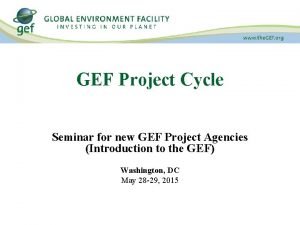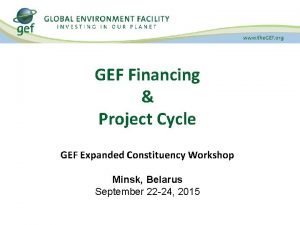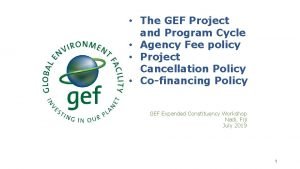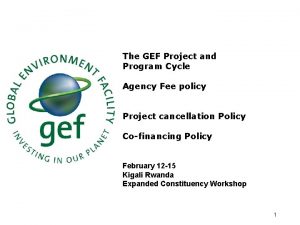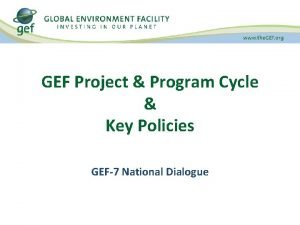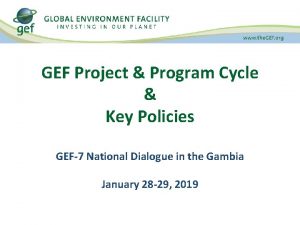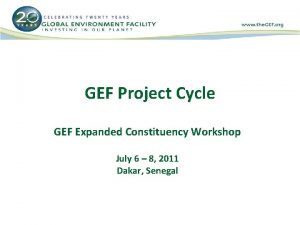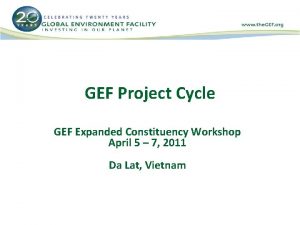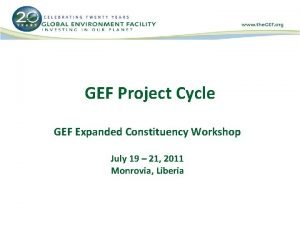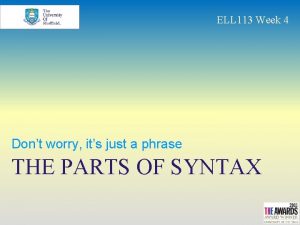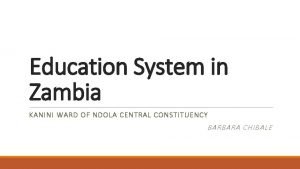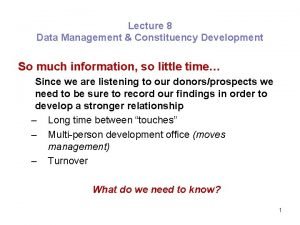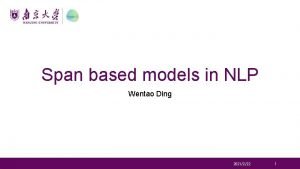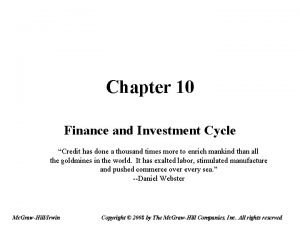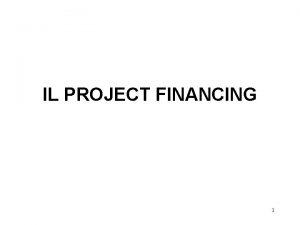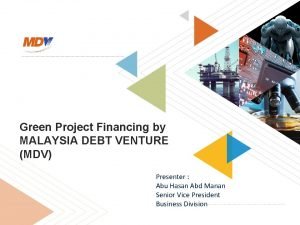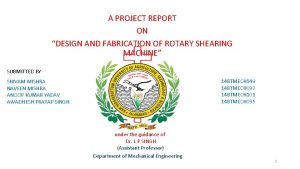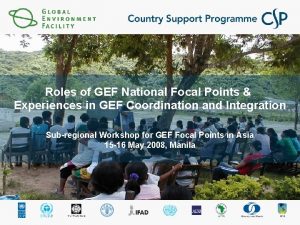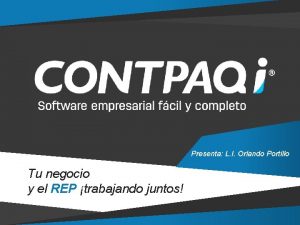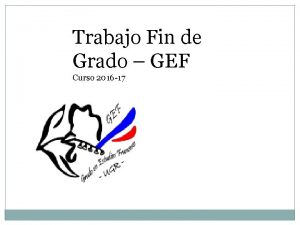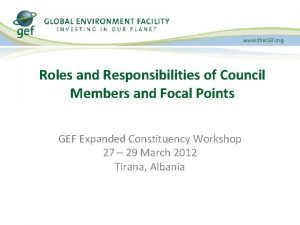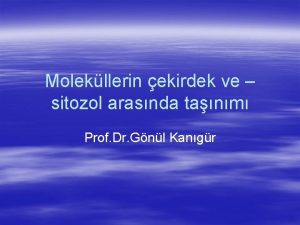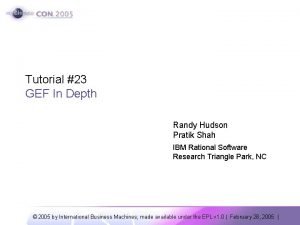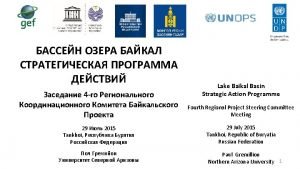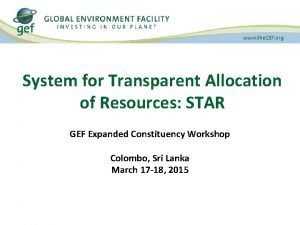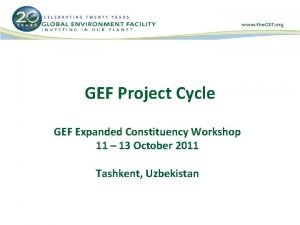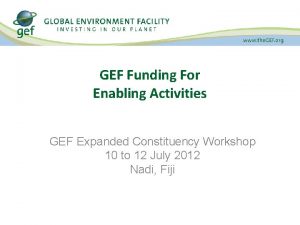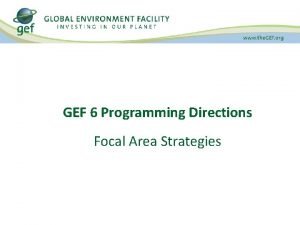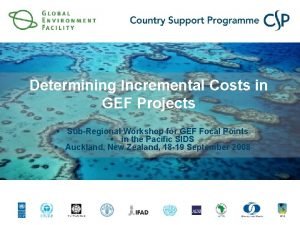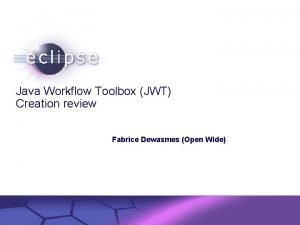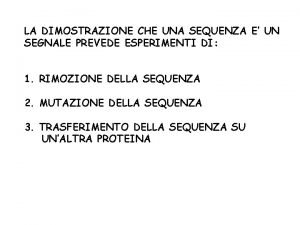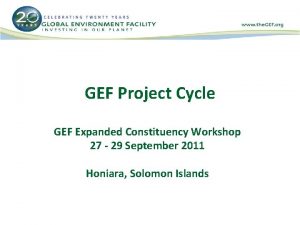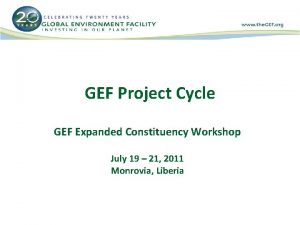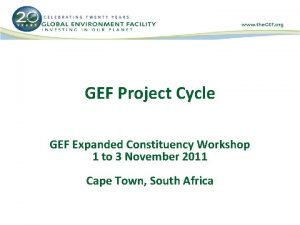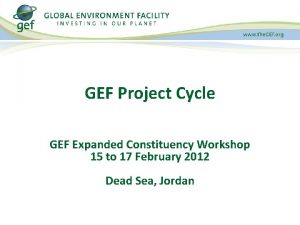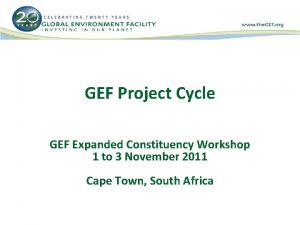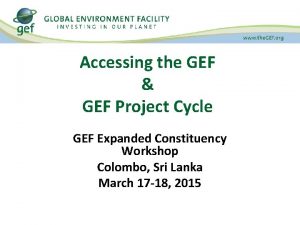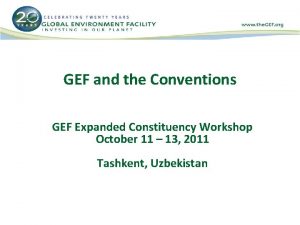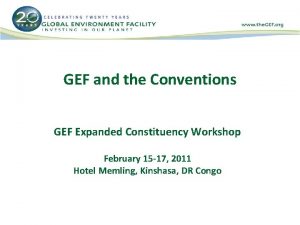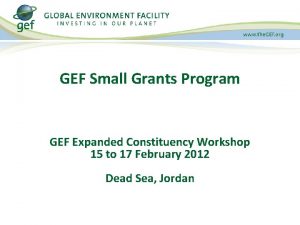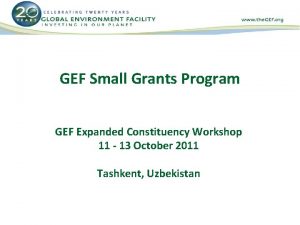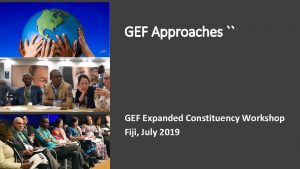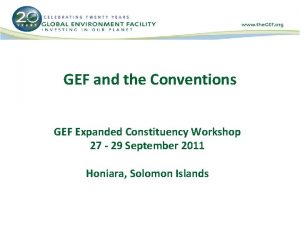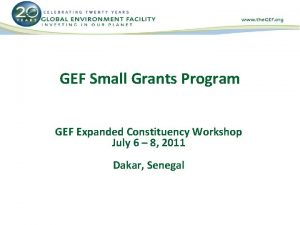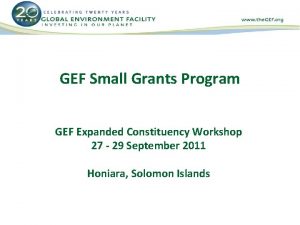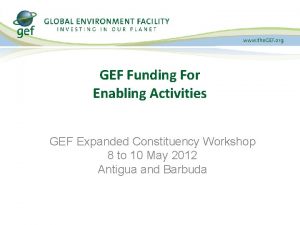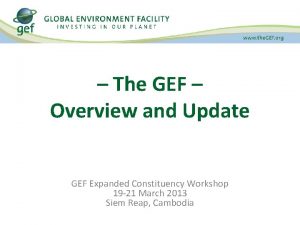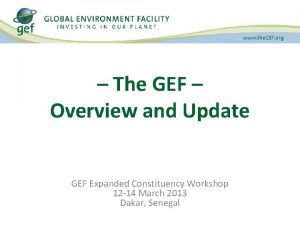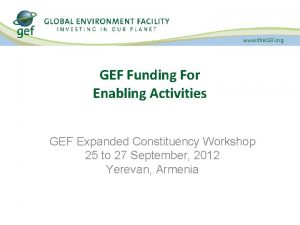GEF Financing Project Cycle GEF Expanded Constituency Workshop





































- Slides: 37

GEF Financing & Project Cycle GEF Expanded Constituency Workshop Minsk, Belarus September 22 -24, 2015

GEF Financing Schemes • • • Full-Sized Projects (FSPs): GEF financing > $2 million Medium-Sized Projects (MSPs): GEF financing < $2 million Enabling Activities (EAs): max. financing per reporting determined by relevant Convention Biodiversity Climate Change Land Degradation CBD UNFCCC UNCCD Nat’l BD Strategies & Action Plan Nat’l Communications 6 th Nat’l Report to CBD Biennial Update Report Chemicals & Waste Minamata POPs Nat’l Mercury Initial Assessment Implementation Plan Artisanal & Small Scale Gold Mining Nat’l Action Plan 3 rd Nat’l Report to Cartagena Protocol • • Project Preparation Grants (PPGs) Project Amount (up to) 1 M 3 M 6 M 10 M Max. PPG amount 50 K 100 K 150 K 300 K Small Grants Program: max. $50 K

Full-Sized Project Cycle GEF Council and Secretariat Step 1: Council approval of Work Program (consisting of PIFs cleared by the CEO) Step 2: CEO endorsement of project GEF Agency Step 3: Agency’s internal approval of project Step 4: Project implementation (project completion follows terminal evaluation and financial closure) STEP 1 GEF COUNCIL approval of Work Program STEP 2 GEF CEO endorsement of project STEP 4 AGENCY project implementation STEP 3 AGENCY approval of project

Medium-Sized Project & Enabling Activity Cycle One-Step Approach Preferred for MSP STEP 1 GEF CEO approval of Final MSP GEF Secretariat Step 1: CEO approval of Final MSP request (w/PPG request, if needed) & Project document GEF Agency Step 2: Agency internal approval Step 3: Project implementation STEP 3 AGENCY project implementation STEP 2 AGENCY approval of MSP

Medium-Sized Project Cycle Two-Step Approach (only if required) GEF Secretariat Step 1: CEO approval of MSP project concept (PIF) submission (w/PPG request, if needed) Step 2: CEO approval of Final MSP request and project document GEF Agency STEP 1 GEF CEO approval of MSP Concept (PIF) STEP 4 AGENCY project implementation STEP 2 GEF CEO approval of FINAL MSP Step 3: Agency internal approval Step 4: Project implementation STEP 3 AGENCY approval of project

Programmatic Approach Cycle GEF Council and Secretariat Step 1: Council approval of Work Program (consisting of PFDs cleared by the CEO) Step 2: Council review of Child Project (only for IAPs) Step 3: CEO endorsement of Child Project GEF Agency Step 4: Agency’s internal approval of project (which signifies start of project implementation) Step 5: Project implementation (project completion follows terminal evaluation and financial closure) STEP 1 GEF COUNCIL approval of Work Program STEP 5 AGENCY project implementation STEP 4 AGENCY approval of Child Project STEP 2 GEF COUNCIL review of Child Project STEP 3 GEF CEO endorsement of Child Project

Country Endorsement Country Operational Focal Point (OFP)’s endorsement letter is the evidence of approval for using the country STAR resources and a key requirement for: ØPIFs (FSPs) to enter the Work Program ØPFDs (PAs) to enter the Work Program ØMSP Requests for CEO approval ØEA Requests for CEO approval ØPPG Requests (often accompanied with baseline projects) Note: Biodiversity, climate change, and land degradation focal area projects are subject to STAR resources.

System for Transparent Allocation of Resources: STAR

Background § The current mechanism by which GEF resources are allocated to countries in three focal areas – Biodiversity, Climate Change, and Land Degradation § The Resource Allocation Framework (RAF) was the first PBA for the GEF and adopted for GEF-4 § The STAR updated the RAF and was implemented for GEF-5 § The STAR was recently updated for GEF-6

Objectives • STAR aims to allocate scarce GEF resources within and among focal areas in order to: Ømaximise impact on the global environment Øpromote sound environmental policies and practices Ømeet convention requirements Ømatch country driven priorities


Calculating STAR allocations 1 • Determine Available Focal Area Funds 2 • Calculate “Country Scores” 3 • Calculate Preliminary Country Allocations 4 • Adjust for Floors and Ceilings 5 • Obtain Final Allocations 6 • Determine post-allocation Flexibilities

Available Focal Area Funds Total Envelope Focal Areas STAR Focal Areas less Set Asides Coun try Allocations

Calculating STAR allocations 1 • Determine Available Focal Area Funds 2 • Calculate “Country Scores” 3 • Calculate Preliminary Country Allocations 4 • Adjust for Floors and Ceilings 5 • Obtain Final Allocations 6 • Determine post-allocation Flexibilities

The main indices • Global Benefits Index: measures a country’s relative share of GEF potential benefits that can be generated by a fixed amount of resource input into a focal area • Country Performance Index: measures a country’s performance and capacity to deliver potential global environmental benefits ******** • GDP Index: designed to increase allocation of countries with a low GDP per capita

The country score COUNTRY SCORE Biodiversity Global Benefits Index Country Performance Index Climate Change Land Degradation GDP Index Country Score = GBI 0. 8 CPI 1. 0 GDP-0. 08

Calculating STAR allocations 1 • Determine Available Focal Area Funds 2 • Calculate “Country Scores” 3 • Calculate Preliminary Country Allocations 4 • Adjust for Floors and Ceilings 5 • Obtain Final Allocations 6 • Determine post-allocation Flexibilities

Preliminary country allocations § Country Share = Country Score / Sum of Country Scores for all eligible countries § Preliminary Allocation = Country Share * Available Focal Area Funds

Approximate Calculation: Trinidad and Tobago BIODIVERSITY GBI 0. 21 CLIMATE CHANGE LAND DEGRADATION 0. 12 CPI 3. 65 GDPI 17934. 06 0. 30 COUNTRY SCORE (GBI 0. 8 CPI 1. 0 GDP-0. 08) 0. 48 0. 306 0. 63 SUM OF COUNTRY SCORES 174. 45 147. 30 189. 39 COUNTRY SHARE 0. 002753 0. 00208 0. 00333 FOCAL AREA ALLOCATION 1051 941 346 PRELIMINARY COUNTRY ALLOCATION 2. 89 1. 96 1. 15 FINAL COUNTRY ALLOCATION 2. 78 2. 29 1. 14 TOTAL ALLOCATION = 6. 22 MILLION (FULLY FLEXIBLE COUNTRY)

Calculating STAR allocations 1 • Determine Available Focal Area Funds 2 • Calculate “Country Scores” 3 • Calculate Preliminary Country Allocations 4 • Adjust for Floors and Ceilings 5 • Obtain Final Allocations 6 • Determine post-allocation Flexibilities

Floors and Ceilings Focal Area Climate Change Biodiversity Land Degradation Floor for LDCs 3 2 1 Floor Ceiling % for Non LDCs 2 10% 1. 5 10% 0. 5 10% Ceilings (US Mn) 126 129. 6 43. 1

Calculating STAR allocations 1 • Determine Available Focal Area Funds 2 • Calculate “Country Scores” 3 • Calculate Preliminary Country Allocations 4 • Adjust for Floors and Ceilings 5 • Obtain Final Allocations 6 • Determine post-allocation Flexibilities

Final allocations § Adjustments for floors and ceilings mean there is a surplus or deficit relative to the preliminary allocation § This is then allocated among countries using the country scores § Process iterates until the full amount has been allocated among countries

Calculating STAR allocations 1 • Determine Available Focal Area Funds 2 • Calculate “Country Scores” 3 • Calculate Preliminary Country Allocations 4 • Adjust for Floors and Ceilings 5 • Obtain Final Allocations 6 • Determine post-allocation Flexibilities

Flexibilities and marginal adjustment § Flexibilities relate to the utilization(not allocation) of GEF resources § Countries are allowed to adjust their focal area allocations (but not their total envelope) Total Allocation X Allowed Marginal Adjustment X ≤ 7 million unlimited X > 7 million 2 million

Approximate Calculation: Trinidad and Tobago BIODIVERSITY GBI 0. 21 CLIMATE CHANGE LAND DEGRADATION 0. 12 CPI 3. 65 GDPI 17934. 06 0. 30 COUNTRY SCORE (GBI 0. 8 CPI 1. 0 GDP-0. 08) 0. 48 0. 306 0. 63 SUM OF COUNTRY SCORES 174. 45 147. 30 189. 39 COUNTRY SHARE 0. 002753 0. 00208 0. 00333 FOCAL AREA ALLOCATION 1051 941 346 PRELIMINARY COUNTRY ALLOCATION 2. 89 1. 96 1. 15 FINAL COUNTRY ALLOCATION 2. 78 2. 29 1. 14 TOTAL ALLOCATION = 6. 22 MILLION (FULLY FLEXIBLE COUNTRY)


Biodiversity Climate Change Land Degradation Country Flexible Total Armenia FALSE 1, 500, 000 2, 000 4, 398, 159 7, 898, 159 Azerbaijan FALSE 1, 500, 000 4, 841, 274 3, 218, 297 9, 559, 571 Belarus FALSE 1, 500, 000 8, 547, 119 500, 000 10, 547, 119 Kazakhstan FALSE 5, 043, 171 11, 808, 681 5, 134, 631 21, 986, 483 Kyrgyzstan TRUE 1, 562, 942 2, 000 3, 035, 782 6, 598, 724 Russian Federation FALSE 25, 434, 939 60, 574, 033 8, 185, 815 94, 194, 787 Tajikistan TRUE 1, 500, 000 2, 776, 009 6, 276, 009 Turkmenistan FALSE 1, 814, 282 4, 987, 726 3, 289, 095 10, 091, 103 Uzbekistan FALSE 1, 784, 252 11, 462, 046 5, 121, 428 18, 367, 726

Key GEF-6 Policies

Agency Fee Policy ALL projects (FSPs, MSPs, EAs & PAs) 10 Existing Agencies 8 Project Agencies $10 M & less Over $10 M 9. 5% 9. 0% (GEF-6 Accreditation Pilot) (irrespective of project amount) Fees for PPGs Same rate as the baseline project Small Grants Program 4. 0% Full-Sized Project Agency Fee : 40/60 tranche payment ü 40% of the fee will be paid after Council approval of Work Program ü 60% of the fee will be paid after CEO endorsement

Project Cancellation Policy Objectives: Ø to improve the GEF’s operational efficiency; ensure timely project preparation & processing Ø to deploy the GEF funding and resources effectively that GEF-financed projects remain relevant to the objectives & priorities of the recipient countries Phased approach FSP PIF Council approval MSP PIF CEO approval • • 12 month Notification to Agency & OFP 6 month Notification to Agency & OFP 18 month Cancellation 12 month Cancellation Exceptions: extraordinary events (i. e. , extraordinary natural disaster/epidemic, war); If justified, Council will be notified. Cancelled projects may be resubmitted within a year (for FSP)/within 6 month (for MSP) for consideration of CEO endorsement/approval, if resources are available.

Co-Financing Policy • “Co-financing” definition: Resources that are additional to the GEF financing (determined on the basis of the agreed incremental cost principle) and that are provided by the GEF Partner Agency itself and/or by other non-GEF sources that support the implementation of the GEF-financed project and the achievement of its objectives. • Co-financing is ü required for Full & Medium-sized Projects, Programmatic Approaches ü optional for Enabling Activities • Required info for Co-financing: source, type (i. e. , grant, loan, guarantee, in -kind) & amount ü Council Approval on Work Program (PIFs & PFDs): indicative info ü CEO Endorsement: confirmed info along w/proof of evidence (i. e. , grant agreement)

GEF and Gender Mainstreaming “As the GEF moves forward with a new and innovative investment strategy, we are deeply committed to initiating and enhancing projects to more effectively deliver on the goals for gender equality while addressing the challenges we face on the global environment. These are not separate issues. Only by engaging partners, both women and men, can we reverse the negative trends threatening our ecosystems and save them for our future generation. ” Naoko Ishii, GEF CEO and Chairperson

Gender Equality Matters GENDER & THE ENVIRONMENT • Women play an important role in managing and preserving biodiversity, water, land other natural resources at the local scale. • Environmental degradation has severe consequences for all human beings and particularly affects the most vulnerable, often women who constitute the majority of the world’s poor. • Women's equal access to and control over resources not only improves the lives of individuals, families and countries, but also help ensure environmental sustainability. GEF’S COMMITMENTS TO GENDER EQUALITY & WOMEN’S EMPOWERMENT Gender equality is an important goal in the context of GEF operations - it helps to advance both the GEF’s objectives of attaining global environmental benefits and those related to gender equality, equity, and social inclusion: • GEF 2020 Strategy • GEF Policy on Gender Mainstreaming (2012) • GEF Gender Equality Action Plan (2014)

Gender Mainstreaming Policy (Agency Minimum Requirements) OPERATIONAL LEVEL PROJECT LEVEL • Institutional capacity & framework for gender mainstreaming: Agency policy that requires to design and implement projects to ensure that both women & men (i) receive culturally compatible social and economic benefits, (ii) do not suffer adverse effects, and that (iii) fosters full respect for their dignity and human rights & Gender focal point • Gender responsive project cycle processes, incorporating socio-economic and gender aspects, including systems for monitoring and evaluating progress on gender mainstreaming. • Social assessment, incl. gender analysis, to assess the potential roles, benefits, impacts and risks for women & men • Integration of specific measures to minimize or mitigate adverse gender impacts • Integration of gender sensitive activities • Gender responsive results-based framework including the use of project level gender disaggregated indicators • Engagement of gender & social experts

Gender Equality Action Plan (GEAP) GEF GENDER PARTNERSHIP (2015) • Comprising of gender focal points from each GEF Agency, Convention Secretariats, Independent Evaluation Office, CSO Network & Indigenous Peoples Advisory Group • Serving as a platform and community of practice & knowledge broker to ensure meaningful and effective coordination of the implementation of the GEAP Ø Project Cycle: Ensure gender-responsive GEF project cycle management processes & procedures, incl. development of guidelines for gender mainstreaming Ø Policy & Programs: Mainstream gender considerations in key GEF policies & programs; support gender responsive projects based on country demand GEF 6 Strategy Ø Knowledge & Learning: Enhance & disseminate knowledge on gender equality & women’s empowerment related to the GEF strategy & project portfolio; facilitate knowledge exchange and visibility Ø Results-based Management: Ensure GEF-wide accountability for gender mainstreaming by strengthening corporate & focal area level indicators to help track progress on gender mainstreaming Ø Capacity Development: Strengthen capacity at GEF Secretariat & staff levels, OFPs & partners at country level

GEF-6 Core Gender Indicators Outcome Indicators Verification Gender-responsive project design 1. Percentage of projects that have conducted gender analysis during project preparation 2. Percentage of projects that have incorporated gender responsive project results framework (e. g. gender responsive output, outcome, indicator, budget) Project Document at CEO endorsement Have the project conducted a gender analysis? Does the project results framework include sex-disaggregated indicators? Project implementation ensuring gender equitable participation in and benefits from project activities 3. Share of women and men as direct beneficiaries of project 4. Share of convention related national reports incorporated gender dimensions (e. g. NBSAP, NAPA, TDA/SAP) (when applicable) Project implementation reports, mid -term evaluation reports (GEF focal area tracking tools) Number direct beneficiaries disaggregated by gender Project monitoring & evaluation giving adequate attention to gender mainstreaming 5. Percentage of monitoring and evaluation report that incorporates gender equality/women’s empowerment issues and assess results Project implementation reports, mid -term evaluation reports (GEF focal area tracking tools) Does midterm evaluation reports (or terminal reports) incorporate gender equality and woman's empowerment issues and assess results ?
 Gef project cycle
Gef project cycle Gef project cycle
Gef project cycle Gef project cycle
Gef project cycle Gef project cycle
Gef project cycle Ceo approval
Ceo approval Gef project cycle
Gef project cycle Gef project cycle
Gef project cycle Gef project cycle
Gef project cycle Gef project cycle
Gef project cycle Gef project cycle
Gef project cycle Constituency tests syntax exercises
Constituency tests syntax exercises Constituency tests syntax
Constituency tests syntax Ndola central constituency wards
Ndola central constituency wards Donor constituency model
Donor constituency model A minimal span-based neural constituency parser
A minimal span-based neural constituency parser Financing and investing cycle
Financing and investing cycle Project financing codice appalti
Project financing codice appalti Project financing definizione
Project financing definizione Project financing malaysia
Project financing malaysia Project report on fabrication workshop
Project report on fabrication workshop What is gef
What is gef Gef roles
Gef roles Https://mifactura.ggef.mx
Https://mifactura.ggef.mx Wvu registar
Wvu registar Trabajar en gef
Trabajar en gef Gef focal points
Gef focal points Ran gef
Ran gef If abc and gef are congruent by the asa criterion
If abc and gef are congruent by the asa criterion Gef tutorial
Gef tutorial Sap виды
Sap виды Gef star allocation
Gef star allocation E student gef
E student gef Gef
Gef Gef
Gef Gef6
Gef6 Gef
Gef Java workflow tooling
Java workflow tooling Sequenze segnale
Sequenze segnale
